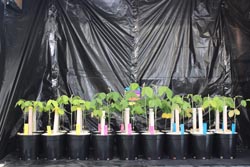Soyabean has been grown since the early 20th century in Zimbabwe with inoculation beginning during the 1960’s. Developments in crop and inoculation technology have progressively increased coverage to present day where inoculant and improved seed are available in every rural province in the country. While the seed industry has benefited from rigorous breeding programmes, inoculation has continued with a narrow range of exotic strains that display superior nitrogen fixation but may be challenged by the local agro-ecologies across the country.
In contrast, indigenous strains may display superior resilience to the Zimbabwean conditions that include soil acidity and high soil temperatures. Previous studies have identified indigenous strains that are compatible with soyabean. Horizontal gene transfer (HGT) is one example of the interactions that occur when populations of rhizobia are mixed, as happens when elite nitrogen fixing inoculant strains are introduced to soils containing environmentally adapted local strains. In the present study, one of the main objectives is to describe population dynamics with respect to HGT, five years after the last introduction of rhizobial inoculants into contrasting environments represented by smallholder farms and soyabean breeding facilities.
|
Figure 1: A comparison of different nutrients levels supplied in a nitrogen fixation optimization experiment. |
Two hundred and eighteen soyabean nodulating strains were isolated by host trapping from soils collected from three soyabean breeding facilities; and from nodules collected from soyabean plants in three smallholder communities. Capturing diversity of source, colony morphology and molecular fingerprinting, 140 strains had combinations of six genes amplified, namely 16s rRNA, recA, glnII, rpoB, nodC and nifH. Preliminary findings have identified strains from the Bradyrhizobium elkanii and Bradyrhizobium japonicum lineages in significant numbers and yet only the Bradyrhizobium diazoefficiens lineage was introduced by inoculation. The 140 strains will be assessed for nitrogen fixation efficiency in the glasshouse. |
In further work, the top 5% in nitrogen fixation efficiency will be assessed for competition against each other in co-inoculation experiments and also individual performance across soyabean cultivars easily accessible in Zimbabwe. Strains that display competitiveness and superior nitrogen fixation will be recommended for use as inoculant strains in Zimbabwe.
Mazvita Chiduwa, PhD student at Murdoch University, Perth, Australia

